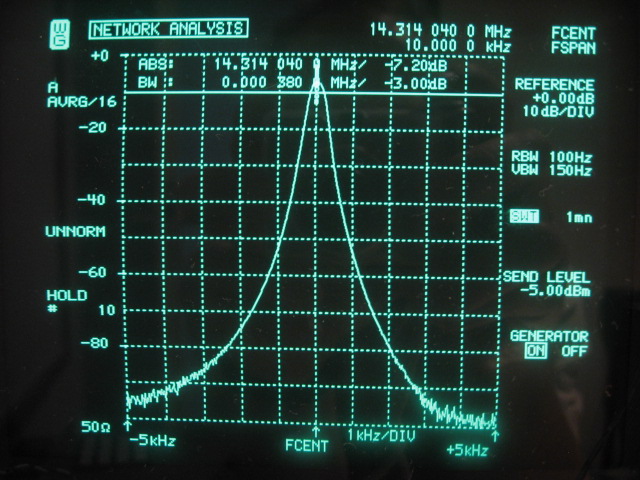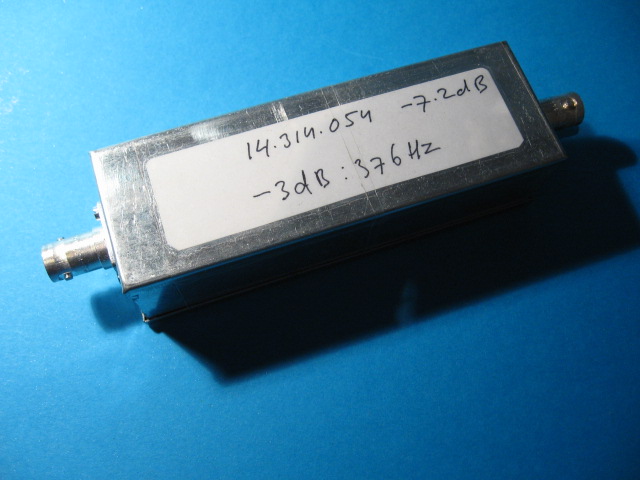Measuring sideband noise using reciprocal mixing
The method is based on the principle of reciprocal mixing between a strong clean reference signal and the LO's noise sidebands. The offset from the carrier where the sideband noise is measured is the offset between the Rx channel and the reference signal. The method is well suited to be used with a receiver directly, where the LO and mixer are already present. The setup is depicted in the following block diagram:

The level of the reference signal is set such that the reciprocally introduced noise inside the receivers channel has the same power as the receivers noise floor. This condition exists when the noise floor is raised by exactly 3dB. The power of the reference signal in dBm, subtracted by the receivers MDS (Minimum Discernable Signal) in dBm is by definition equal to the PNDR of the receiver in dB at the given bandwidth. Given the PNDR and the measurement bandwidth, it is easy to compute the dBc/Hz value of the LO's sideband noise by normalization to 1Hz. So 34dB is added in case of SSB bandwidth to the PNDR to obtain the LO's dBc/Hz value:
PN = -PNDR - 10 * log( BW )
Reference signal
A requirement with this method is that the reference signal should be cleaner than the LO being measured, otherwise the noise of the reference signal will dominate. Reciprocal mixing is working both ways! Therefore the reference signal must be either an ultra low noise (crystal) oscillator or a signal generator that has it noise sidebands shaved off sufficiently by means of a crystal filter in order to be able to measure the noise sidebands of the AD9910 DDS.
One of my AD9951 DDS based generators is used as the reference signal source. See also IP3 measurements. The AD9951 is not without noise, so a crystal filter is used to get rid of its noise sidebands. Crystals, parallel resonant at 14.31818Mhz, are widely available and often quite inexpensive. Therefore a crystal filter at 14.318Mhz is a practical choice. The crystals I have used are labeled with "AQ" and are of surprising good quality. A small batch of 10 crystals were measured which resulted in an average motional resistance of only 5.2Ω and an average Q of 90000!
A simple 4-pole ladder filter is designed with an impedance of 50Ω, which eliminated the need for any impedance matching networks to 50Ω. This filter came out as follows on the network analyzer:

The noise sidebands of the signal generator will be suppressed by -72dB at 2KHz offset, which is much more than is really needed given the performance of the AD9951 based signal generator!
This is what the crystal filter unit looks like, build in ugly style inside a metal enclosure with BNC-connectors:

Measurement Procedure
The measurement procedure is as follows: The signal generator is tuned to the center frequency of the crystal filter and its output level is adjusted such that exactly 0dBm is available at the output of the crystal filter. This very clean 0dBm signal is passed via an accurate step attenuator to the input of the receiver. The step attenuator is used to adjust the reference signal level such that the receivers noise floor is raised by exactly 3dB. Given that:
PNDR = S - MDS, S = - N , and PN = -PNDR - 10 * log( BW )
Results in:
PN = MDS + N - 10 * log( BW )
MDS is the Minimum Discernable Signal, the receivers noise floor in dBm. S is the clean reference signal in dBm, N is the attenuator setting in dB. BW is the measurement bandwidth, usually 2200Hz (SSB).
With this setup, if the MDS is known and the 3dB increase of the noise floor can be measured, the LO noise sideband level can be calculated. The receiver tuned at the appropriate distance from the reference signal, which in this case is at 14.314040MHz, defines the measurement offset.
Measuring the MDS
The MDS of the receiver can be accurately measured using a calibrated signal generator capable of delivering the low signal level corresponding with the MDS. When needed an additional external step attenuator can be used. The signal generator is adjusted such that the signal to noise ratio of the signal at the audio output of the receiver is exactly 0dB. The generators signal output level is exactly the MDS given this condition. To measure the S/N-ratio at the audio output, it is very convenient to use a PC with soundcard and Wolfgang Büscher's, DL4YHF, Spectrum Lab Software. Spectrum Lab has many features one of which is the built-in interpreter with many available functions useful in signal analysis. The interpreter command to be used is:
peak_a(1000,2000) - ( noise_n(1000,2000) + 33.4 )
The peak_a(f1,f2) function returns the value in dB of the highest peak found between frequencies f1 and f2, which should be our signal generator. The noise_n(f1,f2) function returns the average noise power, normalized to dB/Hz between frequencies f1 and f2. An additional 33.4dB is added to noise_n() because the MDS is measured in SSB bandwidth (10 * log( 2200 ) ) rather than 1Hz normalized bandwidth used by noise_n().
Measuring the raised noise floor
Measuring the reciprocally raised noise floor is also made very easy with Spectrum Lab software:
noise_n(800,1000)
The now familiar noise_n() function is used again. The value returned is a number in dB/Hz depending on the actual audio level presented to the PC's soundcard, but its absolute calibration is not important in this application. A relative 3dB raise in the noise level is all we need to measure. A 200Hz measurement interval is useful close-in, where the sideband noise is probably not completely constant over a wider bandwidth.
Reciprocal mixing pros and cons
The reciprocal mixing method has the following characteristics:
-
The method is not very equipment intensive. Typically only a signal generator, a step attenuator, a crystal filter and an AF power meter (Spectrum Lab Software).
-
Calibration is simple. The only calibration needed is to align for 0dBm at the output of the crystal filter.
-
The LO as it is embedded in the receiver is measured, including anything in the LO's signal path like amplifiers, squarers and the mixer itself.
-
Single sideband noise is measured consisting of PM-noise and possibly also AM-noise, depending on the circuits in the LO signal path of the receiver under test.
-
It is not possible to measure really close-in. The main limitation is the bandwidth of the receiver. The reference signal must stay completely outside the receiver's pass-band. So this method cannot measure at offsets less than for instance 1KHz, in case SSB bandwidth is used.
-
Depending on receiver architecture, the possible maximum measurement offset can be limited too by the antenna input filters.
-
A crystal filter is probably needed, in case of ultra-low-noise LO's. Therefore it can only be used at frequencies where a narrow crystal filter is available.
-
Depending on receiver architecture, it may be needed to disable the receiver's AGC action. This is certainly the case if the AGC is active in stages in front of the first mixer. Even if that is not the case, then some IF strips (like Bill Carver's, W7AAZ IF-strip) don't have an AGC threshold at all and that may influence the 3dB noise measurement slightly.
Reciprocal Mixing Variations
The CDG2000 synthesizer documentation also describes the reciprocal mixing method, but with a slight variation. Instead of measuring a 3dB raise of the receiver's noise floor, a more complicated technique is used. A second signal generator is deployed which produces a very weak pilot signal a few dB above MDS inside the pass-band of the receiver. The 3dB reduction in S/N-ratio of this pilot signal is measured using Spectrum Lab. This method is basically the same, but it requires a second signal generator, a combiner and possibly an extra attenuator. This method also works quite well!
Reciprocal Mixing
Crystal Notch Filter
Quadrature Mixing
Back to Sideband Noise Measurement
Back to the TOC
|